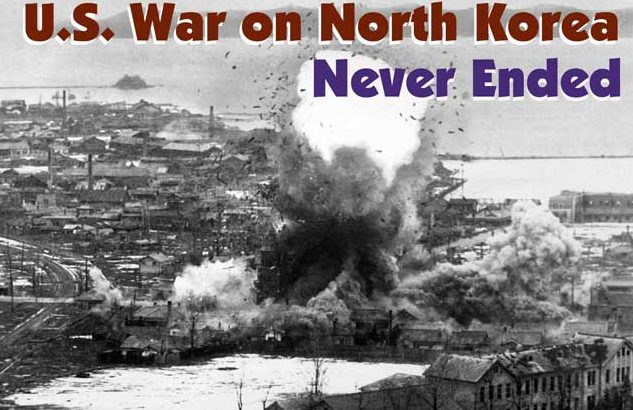“North Korea best not make any more threats to the U.S.
They will be met with fire and fury like the world has never seen.”
(President Trump, 8/8/2017)
“I would get China to make that guy [Kim Jong Un] disappear in
one form or another very quickly”
(Candidate Trump, 2/20/16)
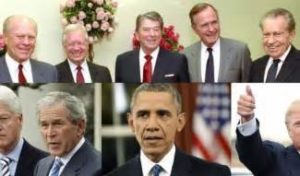
“To be clear, the US does not and never will accept North Korea as a nuclear power. (President Obama, 2016). We will not hesitate to use our military might to defend our allies” (President Obama, 2010)
“States like these [Iran, Iraq, North Korea] … constitute an axis of evil. By seeking weapons of mass destruction, these regimes pose a… growing danger… the price of indifference would be catastrophe.”
(George W. Bush, State of the Union, 1/29/2002)
“I made it as clear as I could that if they were to do that
[attack South Korea] they would pay a heavy price so great that
the nation probably would not survive.”
(President Clinton, November, 1993)
(For a quicker shorter read scroll down to the BLUE FONT)
Four U.S. presidents spanning two decades promising hell fire and fury —pre-emptive attacks, assassination of their leader, economic sanctions (already in place), naming and shaming (on the U.S. list of state sponsors of terrorism, part of the axis of evil), U.S./South Korean war games and military drills less than 30 miles from the 38th parallel (North Korean border). The long list of autocrats, oligarchs, and neo-liberals who run the political leaders who run the U.S. government have their knickers in a knot, contemplating the long shadow North Korea is casting over the newly revitalized dreams of empire stirring in the hearts of U.S. transnational corporations. Similar to 1945, when the smart money bet it would take Russia (our enemy du jour) at least ten and maybe even twenty years to come up with a nuclear weapon to challenge U.S. nuclear hegemony, today’s smart money staked their reputations on North Korea’s mastery of nuclear technology being at best five or ten years away. They were wrong on both counts. Russia did it in less than four years exploding its first nuclear weapon in 1949. On July 28, 2017, a U.S. intelligence report, revealed that North Korea successfully tested an ICBM capable of hitting Los Angeles, Denver, and Chicago. Add in a miniaturized nuclear warhead and the word of words between Kim Jong-un and President Trump shifts into high gear. Ten days later a leaked DIA (Defense Intelligence Agency) report claimed that North Korea had produced such a weapon.
What are we to make of all this? Did the North Korean threat come out of nowhere? At a time (August 21-31) when the U.S. and South Korea are about to undertake their annual military drills cum war games, a dip into the cold waters of history might give us a different perspective on North Korea’s intransigence (as the U.S. sees it) over their nuclear program.
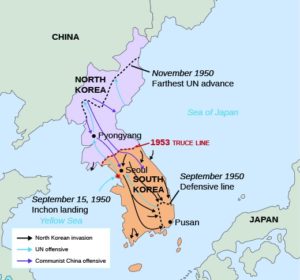 The history of Korea in the twentieth century is a long and sordid tale of US intervention, collusion, and duplicity. Before that for more than a millennium, Korea had been a unified state with discrete boundaries, ethnicity and language. All that changed in 1910 when Japan invaded and colonized Korea with a wink and nod from the US Government.
The history of Korea in the twentieth century is a long and sordid tale of US intervention, collusion, and duplicity. Before that for more than a millennium, Korea had been a unified state with discrete boundaries, ethnicity and language. All that changed in 1910 when Japan invaded and colonized Korea with a wink and nod from the US Government.
As in Vietnam, US fingerprints are all over the arbitrary split of one Korea into two. With the defeat of the Japanese in 1945, fearing Stalin’s takeover of the entire Korean peninsula, and determined to gain a sphere of influence there, the U.S. pushed for the division of Korea at the 38th parallel. The USSR took over the North and the US the South. In 1948, Stalin declared North Korea a sovereign state. The US took a different route. Looking to halt the spread of Communism, they installed Syngman Rhee, a wholly owned subsidiary of the CIA, as the South Korean president. With a resume similar to that of another US puppet, Vietnam’s Ngo Dinh Diem, he followed the usual trajectory of US puppets, surrounding himself with virulent anti-communists and in short order moved from leader to strong man, exiling, imprisoning, and executing opponents.
When Kim Il-sung (grandfather of Kim Jong-un) crossed the 38th parallel in 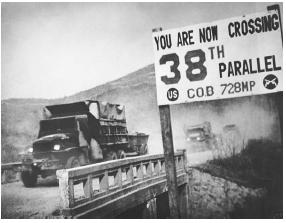 1950 and took Seoul, the US took action, With the connivance of the UN, Truman and Acheson sent ground troops into South Korea to shore up the faltering Rhee regime. By late 1950, US troops had pushed North Korea behind the 38th parallel. At that point the US could have declared victory and gone home, saving the vast majority of the 38,000 American lives squandered in the prolongation of that war. However, bent on snatching defeat from the jaws of victory, the US changed policy horses in midstream and elected to pursue the North Korean army back across the border (a decision made in Washington not by MacArthur).
1950 and took Seoul, the US took action, With the connivance of the UN, Truman and Acheson sent ground troops into South Korea to shore up the faltering Rhee regime. By late 1950, US troops had pushed North Korea behind the 38th parallel. At that point the US could have declared victory and gone home, saving the vast majority of the 38,000 American lives squandered in the prolongation of that war. However, bent on snatching defeat from the jaws of victory, the US changed policy horses in midstream and elected to pursue the North Korean army back across the border (a decision made in Washington not by MacArthur).
Three years and 38,000 US lives later, the US signed an armistice with Korea, pledging to finalize a truce. 67 years have passed. The Korean War is still not over.
***Quicker Read Start Here——>>>>
In North Korea, memories of victimization by the U.S. are a relentless driver of attitudes and actions. At its most opportunistic, memories of US actions on the peninsula have been used mainly by North Korean leaders for political ends —to mobilize public will, and maintain popular support. The past is more ‘present’ in North Korea than it is in the South. As time passes, memory becomes history fixed on past sufferings, past humiliations, unresolved grievances.
In the U.S. memories of North Korea are no less kind though for 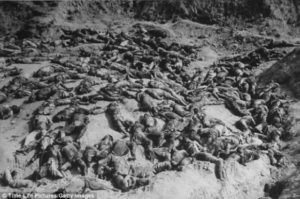 different reasons. The U.S. public’s memory is remarkably short, constant reinvention a national obsession. Americans do not dwell on the consequences of U.S policy. The public barely blinked when work leaked out of the atrocities committed by American and South Korean troops on civilians in North Korea and the bombing raids which destroyed the country. 25% of North Korea’s population was killed by American or American trained forces. North Koreans lost more people (about 4 million) in the Korean War than Japan lost in World War II (2.3 million).
different reasons. The U.S. public’s memory is remarkably short, constant reinvention a national obsession. Americans do not dwell on the consequences of U.S policy. The public barely blinked when work leaked out of the atrocities committed by American and South Korean troops on civilians in North Korea and the bombing raids which destroyed the country. 25% of North Korea’s population was killed by American or American trained forces. North Koreans lost more people (about 4 million) in the Korean War than Japan lost in World War II (2.3 million).
As a measure of how successfully government propaganda molds public opinion, in a recent Gallup poll only 14% of Americans viewed North Korea favorably. Americans have a curious, if understandable myopia when it comes to the Korean War. The march of time shifts the burden of responsibility away from the victimizers and onto the victimized. In the 1950s, “police action” suggested a law enforcement posture for a nation soon to become the self-designated world cop. “Limited war” was the fig leaf hiding the ruinous devastation in lives and property the US air war inflicted on North Korea. Even the US military, historic deniers of victim claims in almost every war the US fought, had no stomach for the usual lies: Major General Emmett O’Donnell, Jr. testifying before the Senate one year into the war, “I would say the entire Korean peninsula is just a terrible mess. Everything is destroyed.”
 Meanwhile domestically, 1950s America was no Garden of Eden for Korean Americans. They faced an array of racist laws. In 15 states, intermarriage between Koreans and Caucasians was prohibited, in California and generally throughout the West Coast Koreans could not own property and in the South had to drink from “colored” water fountains.
Meanwhile domestically, 1950s America was no Garden of Eden for Korean Americans. They faced an array of racist laws. In 15 states, intermarriage between Koreans and Caucasians was prohibited, in California and generally throughout the West Coast Koreans could not own property and in the South had to drink from “colored” water fountains.
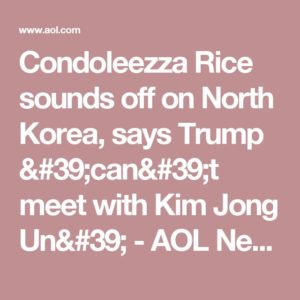 Not surprisingly, for the descendants of a people who cleaned out the indigenous population upon arriving in America and whose inherent racism draws a line in the sand between themselves and the Other (depending on what decade it is the Other may be Korean, Vietnamese, Russian, Chinese or Muslims and this by no means exhausts the possibilities), forgetting becomes a way of reshaping history. Far better to believe Dean Acheson’s pious pronouncement “We have drawn the line in Korea,” or Condoleeza Rice’s characterization of North Korea as “the outpost of tyranny,” or former Secretary of Defense and CIA director, Robert Gates, denunciation of North Korea as a “black hole.” Reshaping history reached new rhetorical heights when President Obama visiting the south Korea labeled the DMZ “freedom’s frontier.”
Not surprisingly, for the descendants of a people who cleaned out the indigenous population upon arriving in America and whose inherent racism draws a line in the sand between themselves and the Other (depending on what decade it is the Other may be Korean, Vietnamese, Russian, Chinese or Muslims and this by no means exhausts the possibilities), forgetting becomes a way of reshaping history. Far better to believe Dean Acheson’s pious pronouncement “We have drawn the line in Korea,” or Condoleeza Rice’s characterization of North Korea as “the outpost of tyranny,” or former Secretary of Defense and CIA director, Robert Gates, denunciation of North Korea as a “black hole.” Reshaping history reached new rhetorical heights when President Obama visiting the south Korea labeled the DMZ “freedom’s frontier.”
Today, North Korea, at U.S. instigation, is the most heavily sanctioned country on the globe with dire consequences for the civilian population – 25% face extreme hunger. The DMZ a two-mile wide stretch separating North and South, by design or happenstance also separates millions of Korean families (possibly 1 in 3 families). During his administration, President Obama maintained a provocatively aggressive stance toward North Korea which included selling nuclear bunker buster bombs to South Korea, advanced weapons systems to Japan and concentrating military resources including stationing nuclear armed submarines and carriers off the coast – all in the name of securing “America’s economic future.” (Hillary Clinton). His successor has been ramping up the rhetoric, including thinly veiled threats of pre-emptive intervention.
In tandem with U.S. verbal bombs, priming the pump of U.S. 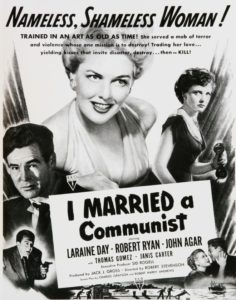 public opinion is a necessary corollary. How better to massage public opinion than with the connivance of a willing ally – Hollywood, the legendary molder of public opinion. Americans have a naïve belief in the veracity of messages delivered electronically — movies, TV, social media? Although some of Hollywood’s most notable actors and actresses became victims of red scare politics during the McCarthy years, the history of Hollywood’s cooperation with US geo-strategic objectives goes back to the invention of motion pictures.
public opinion is a necessary corollary. How better to massage public opinion than with the connivance of a willing ally – Hollywood, the legendary molder of public opinion. Americans have a naïve belief in the veracity of messages delivered electronically — movies, TV, social media? Although some of Hollywood’s most notable actors and actresses became victims of red scare politics during the McCarthy years, the history of Hollywood’s cooperation with US geo-strategic objectives goes back to the invention of motion pictures.
SHORTER READ
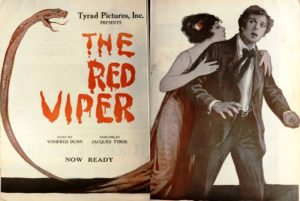 The earliest known film of the Red Scare variety debuted in 1919. Based on the book written by D.W. Griffith, who wrote and directed the unapologetically racist Civil War epic, Birth of a Nation, Red Viper ridicules socialism and government sponsored social welfare “experiments.” Also in 1919, Bullin the Bullshevicki , featuring the familiar Hollywood trope of the young idealist who must be disabused of his naïve Bolshevik beliefs, made audiences shout their approval. The 1951 I Was a Communist Spy for the FBI was an outright propaganda piece to hype the anti-communism sweeping the nation. Although most of these films targeted the USSR as the archetypal “other,” in 1954 as the Korean war ended, Hollywood introduced a new twist on its anti-communist theme,
The earliest known film of the Red Scare variety debuted in 1919. Based on the book written by D.W. Griffith, who wrote and directed the unapologetically racist Civil War epic, Birth of a Nation, Red Viper ridicules socialism and government sponsored social welfare “experiments.” Also in 1919, Bullin the Bullshevicki , featuring the familiar Hollywood trope of the young idealist who must be disabused of his naïve Bolshevik beliefs, made audiences shout their approval. The 1951 I Was a Communist Spy for the FBI was an outright propaganda piece to hype the anti-communism sweeping the nation. Although most of these films targeted the USSR as the archetypal “other,” in 1954 as the Korean war ended, Hollywood introduced a new twist on its anti-communist theme, 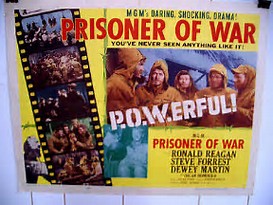 Prisoner of War, starring Mr. Anti-Communism himself, Ronald Reagan, as an intelligence officer who sneaks into a North Korean POW camp to rescue “our” boys. Hands down, the “crème de la crème” of post Korean War movie hit jobs has to be The Manchurian Candidate featuring the North Koreans brainwashing an American POW, the son of a prominent political family, who is transformed into the unwitting assassin of an international communist conspiracy.
Prisoner of War, starring Mr. Anti-Communism himself, Ronald Reagan, as an intelligence officer who sneaks into a North Korean POW camp to rescue “our” boys. Hands down, the “crème de la crème” of post Korean War movie hit jobs has to be The Manchurian Candidate featuring the North Koreans brainwashing an American POW, the son of a prominent political family, who is transformed into the unwitting assassin of an international communist conspiracy.
Not all propaganda movies were made in Hollywood. Throughout the fifties and sixties, the government, particularly the Defense Department, the CIA, and the military, produced a bunch of howlers decrying a variety of “leftist” attitudes labeled “un-American.” In 1961, the Defense Department produced The Challenge of Ideas, a self-described “social values educational documentary,” to convince Americans of the urgent necessity for American military power and less urgently diplomacy and foreign aid to eliminate the “communist menace.” The film was narrated by a hit parade of Hollywood A-Listers, including Edward R. Murrow (whose chummy relationship with the CIA has been well-documented), John Wayne, Lowell Thomas, Frank McGee (longtime NBC correspondent and anchor of the Today show in the 70s) and Helen Hayes.
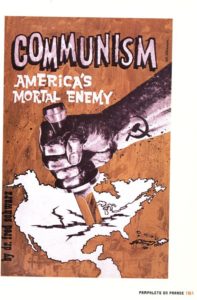
Fast forward to 1984 and Red Dawn, the film that became a cult classic. Here, the U.S. is invaded by the Soviet Union and another US bête noire Cuba. A small group of high school students sets out to take America back.
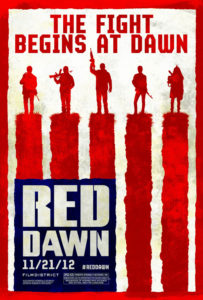
Red Dawn was re-released in 2012 with the same story line, the invasion of the U.S., but the invaders were no longer the Russians or even the Cubans but the North Koreans. They were replacement villains for the Chinese originally scheduled to be the bad guys until the capitalist imperative kicked in and Hollywood realized it was torpedoing a market worth about $1.4 billion. North Korea has no comparable money-making potential.
Two movies in the last decade have tipped the scale when it comes to overtly racist images of North Korean leaders. In 2004, the animated film Team America World Police, was released. Purporting to be a satirical comedy, it features Kim Jong-il (Kim Jong-un’s father) as a giant cockroach from another planet.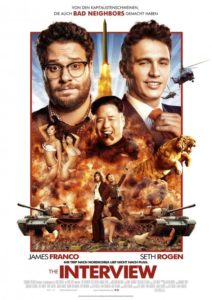 Ten years later, The Interview featuring a CIA plot to assassinate Kim Jong-un was released. Kim Jong-un is pictured as a “really bad guy” complete with a close up of an exploding head. Audiences howled with delight.
Ten years later, The Interview featuring a CIA plot to assassinate Kim Jong-un was released. Kim Jong-un is pictured as a “really bad guy” complete with a close up of an exploding head. Audiences howled with delight.
To insulate itself against blowback for its caricature of Kim and “spoof” of the Korean language, Sony declined to show the film in South Korea. When its computer systems were hacked releasing a trove of embarrassing emails, Sony’s threw in the towel and pulled the film world-wide. The uproar in the U.S. was instantaneous. George Clooney, consummate insider and official arbiter for human rights issues in Tinsel Town, fought back tears: “We know that to give in to these criminals now will open the door for any group that would threaten freedom of expression and personal liberty…we will not stand in fear.”
Here’s Seth Rogen, director, lead actor, and first-class dumbbell: “And if it does start a war, hopefully people will say ‘You Know What? It was worth it. It was a good movie… We…did lots of research. We tried to make him…adorable. We tried to…explain what is really bad about it [North Korea] and it is really bad.” From this stew of incomprehensible reasoning, some may wonder who the “really bad” character is– the country held up to scorn and ridicule, or the country that thinks a close-up of an exploding human head is funny? Point of interest: Seth Rogen was paid $8.4 million to make this film (costar James Franco pocketed $6.5 million). Talk about laughing all the way to the bank.
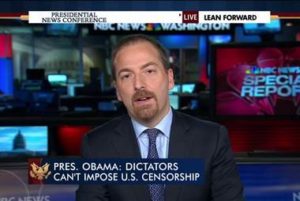 Even former President Obama was horrified at Sony’s decision to pull the film. “We cannot have a society in which some dictator some place can start imposing censorship in the United States.” He might have added that we don’t have the same high-minded principles when it comes to whistleblowers.
Even former President Obama was horrified at Sony’s decision to pull the film. “We cannot have a society in which some dictator some place can start imposing censorship in the United States.” He might have added that we don’t have the same high-minded principles when it comes to whistleblowers.
Leave it to the The New York Times, to get right to the heart of the matter. “…American pop culture is…our greatest achievement and most popular export…We are at our best when we are funny, stupid, sincere, and immature and that’s why everybody loves us. Even if we sometimes have troubling admitting how much we love each other.” (my emphasis).
A country that surrenders its nuclear capability on the altar of U.S. promises has forgotten how quickly some decisions come back to bite the decision maker. Remember George W. Bush in 2003 congratulating Gaddafi on his decision to halt his nuclear weapons program — “leaders who abandon the pursuit of chemical, biological and nuclear weapons… will find an open path to better relations with the United States and other free nations.” Eight years later, President Obama bombed Libya out of existence and gave tacit approval to his murder. North Korea knows how powerful nuclear capability can be in confronting bullies on the world stage: “Libya’s nuclear disarmament…turned out to be a mode of disarmament where the [U.S.] coaxed [Libya]…to disarm and then swallowed it up by force.” (North Korean Foreign Minister)
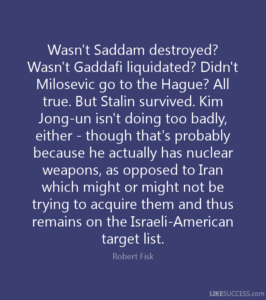 Even U.S. intelligence leaders have trouble faulting North Korea’s logic. In 2016, General James Clapper, Obama’s Director of National Intelligence, told the truth he generally finds so elusive: “[Nuclear weapons are North Korea’s] ticket to survival.” On July 21, 2017, Dan Coates, President Trump’s Direction of National Intelligence, threw another bone Kim Jong-un’s way — “there is some rationale backing his [Kim Jong-un’s] actions which are survival, survival for his regime, survival for his country… The lessons that we learned out of Libya giving up its nukes and Ukraine giving up its nukes is unfortunately if you have nukes, never give them up. If you don’t have them, get them.”
Even U.S. intelligence leaders have trouble faulting North Korea’s logic. In 2016, General James Clapper, Obama’s Director of National Intelligence, told the truth he generally finds so elusive: “[Nuclear weapons are North Korea’s] ticket to survival.” On July 21, 2017, Dan Coates, President Trump’s Direction of National Intelligence, threw another bone Kim Jong-un’s way — “there is some rationale backing his [Kim Jong-un’s] actions which are survival, survival for his regime, survival for his country… The lessons that we learned out of Libya giving up its nukes and Ukraine giving up its nukes is unfortunately if you have nukes, never give them up. If you don’t have them, get them.”
The mainstream media is right — Kim Jong-un is crazy. What they forget to mention is that he’s crazy—like a fox.
